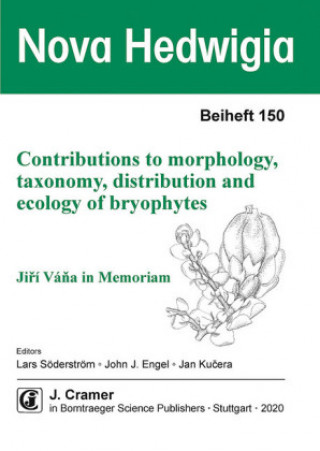
Kód: 38507479
Contributions to morphology, taxonomy, distribution and ecology of bryophytes
Autor John J. Engel, Jan Kucera, Lars Söderström
The content of the contributions to this volume is diverse, and deals with morphology, taxonomy, distribution, and ecology of bryophytes. During the last 20 years much attention has been given to the morphology, development, and ... celý popis
- Jazyk:
 Angličtina
Angličtina - Väzba: Brožovaná
- Počet strán: 334
Nakladateľ: Borntraeger, 2020
- Viac informácií o knihe

136.06 €
Bežne: 136.07 €
Ušetríte 0.01 €
Dostupnosť:
50 % šanca Máme informáciu, že by titul mohol byť dostupný. Na základe vašej objednávky sa ho pokúsime do 6 týždňov zabezpečiť.
Máme informáciu, že by titul mohol byť dostupný. Na základe vašej objednávky sa ho pokúsime do 6 týždňov zabezpečiť.Prehľadáme celý svet
Mohlo by sa vám tiež páčiť
-

Introduction to Bryophytes
72.28 € -

Hayao Miyazaki
53.13 € -5 % -

Biology of Algae, Lichens and Bryophytes
166.78 € -

Umění starých herbářů
33.57 € -16 %
Darujte túto knihu ešte dnes
- Objednajte knihu a vyberte Zaslať ako darček.
- Obratom obdržíte darovací poukaz na knihu, ktorý môžete ihneď odovzdať obdarovanému.
- Knihu zašleme na adresu obdarovaného, o nič sa nestaráte.
Informovať o naskladnení knihy
Zadajte do formulára e-mailovú adresu a akonáhle knihu naskladníme, zašleme vám o tom správu. Postrážime všetko za vás.
Viac informácií o knihe Contributions to morphology, taxonomy, distribution and ecology of bryophytes
Nákupom získate 336 bodov
 Anotácia knihy
Anotácia knihy
The content of the contributions to this volume is diverse, and deals with morphology, taxonomy, distribution, and ecology of bryophytes. During the last 20 years much attention has been given to the morphology, development, and phylogeny of the liverwort Treubia, which occupies a pivotal position as one of the lineages in the first diverging clade in phylogenetic reconstructions of the Marchantiophyta. The important patterns of spore germination and sporeling development, while known for such genera as Haplomitrium, Fossombronia and Monoclea, had heretofore not been studied in Treubia. Crandall-Stotler & Bartholomew-Began (p. 57-66) found that, in fact, the early stages of sporeling ontogeny of Treubia resemble those of these three genera, but that there are considerable developmental differences among the taxa beyond the nine-celled stage of the sporelings. The early stages of germination and sporeling development, as well as apical cell formation, are nicely illustrated with line drawings and scanning electron micrographs. Molecular data helped to uncover or elucidate several unattended problems in various taxonomic groups and ranks. In one of them (Larraín et al.,p. 97-108), they were necessary even to suggest correctly the familial placement of a moss newly discovered in the Andes Mountains of central Chile and in the Falkland Islands. The extremely reduced morphology in both sporophytic and gametophytic traits could perhaps only unequivocally assign the species to the subclass Dicranidae, but molecular data convincingly pointed towards the poorly understood family Rhabdoweisiaceae. The authors provide a very useful and detailed analysis of the genera currently assigned to the family, and established a new genus, Notocynodontium, for their new peculiar moss. Two of the papers touched on generic delimitations: Kucera & Hedenäs (p. 165-178) revisited the genus Campyliadelphus and found that while the type species, C. chrysophyllus, should be merged with the genus Campylium, another currently accepted species, C. elodes has stronger affinities with Cratoneuron and Palustriella, necessitating the erection of a new genus, Kandaea, for C. elodes, and honouring thus the author, Hiroshi Kanda, who contributed significantly to the knowledge of Campylium-like species in the 1970s. Kucera et al. (p. 273-292) investigated the molecular affinities of two pottiaceous species recently recorded in Asian Russia, Bryoerythrophyllum sollmanianum and Tortula yuennanensis, and found again, how deceiving the superficial morphological similarities can be: While the latter species was found deeply nested in Bryoerythrophyllum and had to be combined into that genus (albeit with a new name, B. chenii), B. sollmanianum was found completely unrelated to the rest of Bryoerythrophyllum taxa, and a new genus, Pararhexophyllum, had to be described for it, acknowledging the molecular-phylogenetic affinities to the Central- and South American monospecific genus, Rhexophyllum. Ignatov et al. (p. 243-264), revisited a well-known genus, Fontinalis, which, however, harbours a suite of taxa difficult to delimit in both morphological and molecular way. Plants earlier referable to F. antipyretica var. gracilis were found to occur in two lineages; Asian specimens are referred to a resurrected species, F. perfida, while the European and West-Asian plants are retained a varietal rank within F. antipyretica, albeit with an older name, F. antipyretica var. minor. The unresolved relationships of some "small" taxa recognised by some authors and the nested position of F. squamosa within F. antipyretica s.str. awaits further taxonomic novelties in this group in the near future. Molecular data are also used to gain new insights into taxonomy and systematics of liverworts. Gradstein (p. 81-96) used both new molecular and morphological results in his review of the changes of classification of Lejeuneaceae genera in Tropical America since 2001. A major new classifica
 Parametre knihy
Parametre knihy
136.06 €
- Celý názov: Contributions to morphology, taxonomy, distribution and ecology of bryophytes
- Podnázov: Jirí Vána in memoriam
- Autor: John J. Engel, Jan Kucera, Lars Söderström
- Jazyk:
 Angličtina
Angličtina - Väzba: Brožovaná
- Počet strán: 334
- EAN: 9783443510725
- ID: 38507479
- Nakladateľ: Borntraeger
- Hmotnosť: 710 g
- Rozmery: 240 × 170 × 15 mm
- Rok vydania: 2020
Obľúbené z iného súdka
-

Dune
13.10 € -

Haunting Adeline
30.81 € -

Berserk Deluxe Volume 2
52.62 € -

White Nights
3.57 € -24 % -

Powerless
12.48 € -4 % -

Atomic Habits
15.96 € -15 % -

Dune Messiah
9 € -20 % -

Berserk Deluxe Volume 3
52.92 € -

One Day
12.58 € -13 % -

Berserk Deluxe Volume 1
52.21 € -23 % -

Iron Flame
16.27 € -19 % -

Surrounded by Idiots
10.13 € -16 % -

Harry Potter and the Prisoner of Azkaban (Minalima Edition)
27.84 € -32 % -

Gravity Falls Journal 3
22 € -

Heaven Official's Blessing: Tian Guan Ci Fu (Novel) Vol. 1
22 € -

The Creative Act
24.05 € -

Dune
9.72 € -19 % -

Hunting Adeline
31.83 € -

A Little Life
17.50 € -

Children of Dune
8.80 € -22 % -

Heaven Official's Blessing: Tian Guan Ci Fu (Novel) Vol. 2
25.28 € -

Bungo Stray Dogs, Vol. 8 (light novel)
16.06 € -1 % -

Percy Jackson and the Olympians 5 Book Paperback Boxed Set
47.80 € -

Solo Leveling, Vol. 1
21.49 € -

The Prisoner's Throne
10.64 € -21 % -

Court of Thorns and Roses
9.31 € -22 % -

Cry Baby Coloring Book
10.84 € -4 % -

Fourth Wing
16.68 € -16 % -

Icebreaker
9.41 € -16 % -

Berserk Deluxe Volume 6
52.21 € -23 % -

Avatar, the Last Airbender: The Kyoshi Novels (Box Set)
27.53 € -33 % -

The 48 Laws of Power
26.92 € -1 % -

House of Leaves
23.23 € -4 % -

Twisted Lies
9.72 € -19 % -

Dune Messiah
12.69 € -12 % -

No Longer Human
16.99 € -

48 Laws Of Power
22.62 € -5 % -

Twisted Games
9.41 € -22 % -

Caraval Paperback Boxed Set
41.35 € -4 % -

Solo Leveling, Vol. 2
22.41 € -

Open Circuits
34.39 € -16 % -

Berserk Deluxe Volume 5
51.29 € -

Heaven Official's Blessing: Tian Guan Ci Fu (Novel) Vol. 3
16.78 € -19 % -

Berserk Deluxe Volume 4
46.58 € -8 % -

Court of Mist and Fury
9.31 € -20 % -

SOLO LEVELING V08
22.41 € -

English File Upper Intermediate Multipack A (4th)
22.21 € -

CHAINSAW MAN V14
11.25 € -14 % -

Before the Coffee Gets Cold
10.43 € -20 %
Osobný odber Bratislava a 2642 dalších
Copyright ©2008-24 najlacnejsie-knihy.sk Všetky práva vyhradenéSúkromieCookies


 19 miliónov titulov
19 miliónov titulov Vrátenie do mesiaca
Vrátenie do mesiaca 02/210 210 99 (8-15.30h)
02/210 210 99 (8-15.30h)